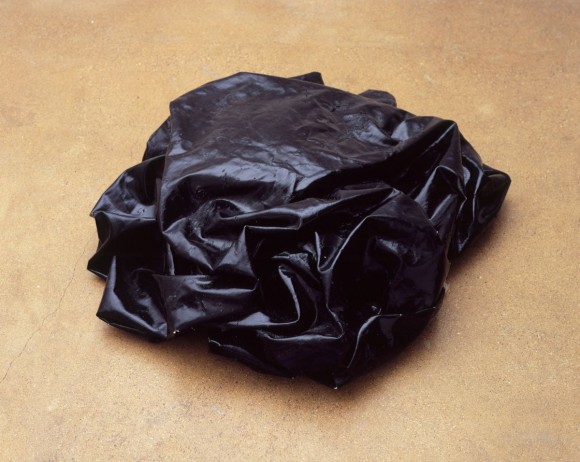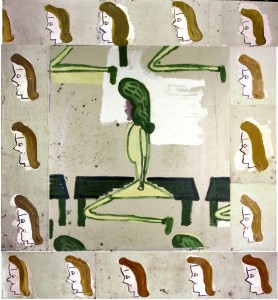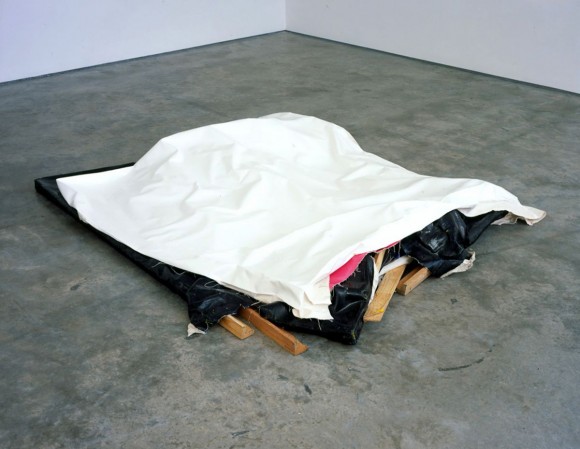
Angela de la Cruz, "Nothing 1," 1998. Oil on canvas. Courtesy the artist and Lisson Gallery, London.
Writing about painting isn’t easy, simply because painting isn’t built to be written about. So writers writing about painting tend to rely on a checklist of clichés: the one about everyone thinking painting was dead, then (like an inverted Weekend at Bernie’s) finding out it wasn’t. Or the one about painting lagging behind other forms of art because it isn’t brainy enough. Or the one about painting being challenged by photography, or besieged by video art, or troubled by conceptualism — all ideas that bespeak a kind of insecurity on the part of art writers who can’t quite believe that a form of creation much older than the novel (that other persistent hanger-on) and almost as old as fire and shelter (also still quite popular) continues to be made by otherwise perfectly nice, intelligent, and right-thinking human beings.
Painters tend to stick in the throat of the contemporary art establishment not because they’re still mucking about in the shallow end of cultural history but because they fail to toe the intellectual party line. They won’t critique institutions, generate participative experiences, hold a mirror up to our (we’re told, but I’ve yet to find anyone who actually believes this) media-bombarded, meta-simulacral society or even (for the love of God!) provide their own commentary on the problematics of making art in the first place. No. Instead, these painters continue to spend hours in messy rooms dirtying up their Birkenstocks making objects to be hung on walls. What a waste!
Some contemporary painters, admittedly, paint with an eye to their work’s transcription into a wall label or press release. A whole slew of post-Tuymans, weak-wristed painters (including, sometimes, the man himself) are guilty of that, from Marlene Dumas on down. That strain in painting – nervous, thinly-applied translations of enigmatic photographic sources – is a boon for the art writer, for whom a lot of such works appears to have been made (a recent show of Eberhard Havekost at White Cube is a good example of this). It’s not a stretch to see that tradition as a kind of insecure commentary on the nature of images in contemporary society. Similarly, a kind of ironic abstraction has tended to dominate painting in recent years, taking its cue perhaps from Tomma Abts, with Blinky Palermo and Peter Halley as its patron saints. That tradition slots in nicely with a dominant strain in other art practices, the tireless and joyless unpicking of modernist utopianism.
Both strains in painting are hard to love, since they postpone or even nullify the principal joy of experiencing painting, which is looking at paint. The good news is that because of those think-first, act-later artists (who, you feel, might be happier not painting), there’s a certain amount of renewed attention given to painting in general. This is particularly good news for the many painters working today whose work fails to readily comply with the established clichés of talking about painting. It’s hard to feel down about contemporary art when painters such as Rose Wylie, Laura Owens, Peter Doig, Michael Borremans, Tal R, Chris Ofili, and Mary Heilmann are working, to name only a few.

Rose Wylie, "Sitting on a Bench with Border," 2006. Courtesy Union Gallery.
Add Angela de la Cruz to that list. Her new show at Camden Arts Centre (seriously: the best place to see contemporary art in London), a spare retrospective of ten-something years of painting, treats painting as slapstick activity, something run-down and haggard but fighting fit nonetheless. She’s the funniest painter since James Ensor. De la Cruz was born in La Coruña in northwestern Spain, where Picasso learned to paint; there’s nothing very Picasso-y about De La Cruz’s work (except, perhaps, for a dim memory of Nabakov’s “abstractist bric-a-brac”), but there’s no mistaking the memory of her native Baroque in her theatrical treatment of the picture. She moved to London in 1989 and studied under Phyllida Barlow at the Slade School of Art; coincidentally, Barlow’s sprawling, anarchic sculptural objects (like a messier Jessica Stockholder) are finally getting the attention they deserve.
Every artist needs a lightbulb moment, and De La Cruz’s came with a broken cross bar on one of her works, which she removed: “From that moment on, I looked at the painting as an object.” That’s a bit disingenuous, considering the (by then) long history of painters doing just that, from Schwitters busting the painting/object boundary by gluing bus tickets to his pictures, to Rauschenberg’s anything-goes combines of the fifties, which lean out of the wall to steady themselves on the floor. De La Cruz’s work doesn’t overload itself aesthetically, though, as (say) Rauschenberg’s or Chris Ofili’s does (or did): rather, she starts from a position of more or less pure abstraction. Each painting is, mainly, monochrome, the paint loaded on in fat striations of glossy oil. That the painting part is calm and steady-handed is the set-up to the punchline. her next move is to tear the canvas from its stretcher and leave it hanging off, or remove the entire thing and dump it on the ground, or stretch it over pieces of furniture. Works are shoved into the corner and sag there like ancient mattresses; others seem to have skittered, terrified, against the wall. No work receives attention passively. Her best work dramatizes a tension between making and showing, each luscious monochrome getting a sudden attack of stage fright on opening night.

Angela de la Cruz, "Clutter VI with White Blanket," 2006
De La Cruz’s approach – asserting painting as an object in space, rather than as a window into a made-up world – may be as old as the hills by 2010, but what it does most effectively is provide a moment of pause for painting itself. Her titles – Homeless, Ashamed, Nothing, Deflated – are self-effacing to the point of solipsism, and allude, she says, to “the embarrassment of being a painter in the 1990s.” If the real human condition, as Kurt Vonnegut put it, is embarrassment, it’s dramatized in painting more acutely than anywhere else. Painting is the embarrassing little brother in the contemporary art family, picking his nose in the family photo. And yet painting, despite nearly 200 years of announcements to the contrary, still lives and breathes — this awkward, persistent backseat driver baying, “Are we there yet? Are we there yet?”




Pingback: Letter from London: Turner Blind Eye | Art21 Blog
Pingback: Young Celebrities Mika Dela Cruz » Images Search